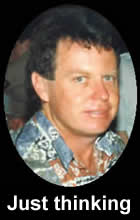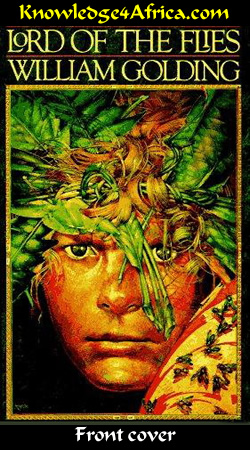|
READ THIS
This chapter presents a most graphic funeral image: Simon slain but the creatures of the magical,
mystical world visiting him at his funeral, converting his body in a ceremony of alchemy and then bearing
it out to sea to join the gods which dwell in the deeps.
 THE USE OF IMAGES
THE USE OF IMAGES
An image is a sustained picture in words. Either it is sustained over the duration of a paragraph, a page
or even the book as a whole. A certain character or an event might be at the centre of the image.
In Charles Dickens's Great Expectations, one is presented with a prison image. The book opens
with the hero Pip being confronted by an escaped convict.
During the rest of the novel, however, Pip finds himself in a prison of his own, unable to escape. The
novel is dark and full of shadows, like a prison.
Lord of the Flies, on the other hand, is full of religious images. Indeed, its very name conjures
up such an image, and the author begs the reader to reflect on why he has given this book such a name.
"Lord of the Flies" is the English translation of the Hebrew word "Beelzebub", one of the
several manifestations of Satan.
It was the "Lord of the Flies" who had taken possession of the boys' hearts and minds. It was he
whose presence caused conflict and death within the community of boys.
Several times in the novel, the author refers to what is known as a "Christ image", i.e. someone
acts in much the same way as the biblical Jesus Christ.
To make the "Christ image" work, however, the reader has to be aware of specific incidents in the
life of Jesus Christ which has parallels the life of boys on the island.
One such story is the meeting of Jesus with the Evil One in the wilderness. Satan tempted Jesus with
offerings of power and wealth.
At face value, the temptation would seem irrelevant but Jesus rejected it with contempt because, although
he would indeed eventually possess eternal power as the Son of God, this was nevertheless secondary
to his primary agenda: the salvation of mankind.
In this novel, it is Simon who recognised the Evil One going under the title "Lord of the Flies".
Like Jesus, Simon went out into the wilderness and confronted the Evil One who had taken up symbolic
residence at the fly-infested pig's head placed there as an offering.
But before Simon could reveal this truth, he was executed during a ritual dance. Beelzebub then
continued to work his evil on the boys.
But there are also other images used in this book. Sexual images. Magical, mystical funeral images. Be
sure to watch out for them because they play an important place in this story.
Have you looked at the questions
in the right column?
|
TEST YOURSELF!
Read the left column and then answer
the following questions:
Along the shoreward edge of the shallows the advancing clearness was full of strange,
moonbeam-bodied creatures with fiery eyes. Here and there a larger pebble clung to its own air and was
covered with a coat of pearls. The tide swelled in over the rain-pitted sand and smoothed everything with
a layer of silver. Now it touched the first of the stains that seeped from the broken body and the creatures
made a moving patch of light as they gathered at the edge. The water rose further and dressed Simon'
s coarse hair with brightness. The line of his cheek silvered and the turn of his shoulder became
sculptured marble. The strange, attendant creatures, with their fiery eyes and trailing vapours, busied
themselves round his head. The body lifted a fraction of an inch from the sand and a bubble of air escaped
from the mouth with a wet plop. Then it turned gently in the water.
Somewhere over the darkened curve of the world the sun and moon were pulling; and the film of water
on the earth planet was held, bulging slightly on one side while the solid core turned. The great wave of
the tide moved further along the island and the water lifted. Softly, surrounded by a fringe of inquisitive
bright creatures, itself a silver shape beneath the steadfast constellations, Simon's dead body moved out
towards the open sea.
- What purpose do these "strange, moonbeam-bodied creatures with fiery eyes" have in this
scene? (6)

[Need help?]
This is a funeral scene, right? But what type of funeral? And what type of funeral image does the author
wish to use?
The author has already presented Simon to us as a Christ image: like Jesus Christ, he went up the
mountain and spoke with the devil who offered him temptations. Like Jesus Christ, Simon refused, and
then came down the mountain to tell the people the truth -- for which he was killed, just like Jesus Christ.
Of course, one can't take this image too far and so the author changes things for the funeral. Simon is
buried at sea in a fantastical, mystical funeral scene.
The "strange, moonbeam-bodied creatures with fiery eyes" are part of that image.
|
- Explain the comment that "a larger pebble clung to its own air". (4)

[Need help?]
In one sense, this is a contrast with Simon. The boy found it impossible to cling to his own air but died
there on the beach. The pebbles, however, are alive, breathing, clinging to their own air.
It is, of course, a natural phenomenon of the water closing over the pebbles, trapping the air inside hollows
and indentations.
|
- Explain the meaning of the "coat of pearls". (4)

[Need help?]
The author has described the little globules of phosphorescence which has been coming in on the tide.
This phosphorescence has coated everything in a shiny film of white, making it look like coats of pearls.
|
- Explain the purpose of dressing Simon's hair "with brightness". (4)

[Need help?]
Once again we are witnessing the phosphorescence which has covered Simon's hair, making his hair
shiny and silver, and glowing like it was lit up.
|
- What image is the author portraying when he describes the line of Simon's cheek being
"silvered" and his shoulder "sculptured marble"? (4)

[Need help?]
There is an alchemy happening here. Alchemy was a magic practised by medieval magicians who
attempted to turn ordinary base material in something precious, like turning lead into gold.
Simon's body becomes part of that alchemy. His cheek turns from flesh to silver, his shoulder changes
from that of a little boy into something marbled, like the sculptured bust of a Greek god.
It is, of course, all to do with the phosphorescence but its effect is magical -- an alchemy in nature.
|
The description of the burial of Simon in the sea is a remarkable funeral image within a fantastical,
magical, mystical world.
- Explain this funeral image. (10)

[Need help?]
This question calls for a discussion of images -- so please read the notes in the left column.
In this case, the author has used a funereal image of a creature -- Simon -- being caught up into a
magical, mystical world of alchemy, where his body is changed by magic into something hauntingly
beautiful, while all the magical mystical creatures of the ocean attend and carry Simon's body into their
wet world of magic.
Note the shiny creatures with fiery eyes, the coat of pearls, the conversion of Simon's cheek and shoulder
into sculptured marble, the little creatures preparing the body until the sea itself turns it round and carries
it away for burial.
|
Simon's death in itself meant much more than just the murder of an innocent child.
- Why had the boys killed Simon? (10)

[Need help?]
In one sense, it was an accident. The boys had been whipped up into a frenzy of fear. They were not only
afraid of the storm but also of the beast which they thought was lurking somewhere in the dark.
Although they were role-playing the killing of a pig, nevertheless when Simon came creeping on all fours
into their circle, he immediately became the evil beast in their eyes.
It's not that they didn't recognise Simon. They probably did consciously recognise him but their
subconscious was now in complete control, and this subconscious part of their mind believed it was the
beast in their midst.
Such a beast needed immediate killing before it could recover and possess them. And, as the beating
became a frenzy, so Simon became more and more the beast even in their conscious mind -- till he was
quite dead and they recovered and realised what they had done.
|
- Explain Simon's death within the greater tapestry of religious imagery. (10)

[Need help?]
Have you read the notes in the left column? If not, then please do so.
Religious imagery makes use of such thing as Christ images and magical, mystical images. A halo round
one's head. Strange creature with red eyes. A child speaking to a pig's head, debating the issue of evil.
All this is religious imagery.
Simon in particular is a Christ image. Like Jesus Christ, he was innocent but went up the mountain to
confront the devil. Like Jesus Christ, Simon disputed with the devil -- in the form of Beelzebub or the
Lord of the Flies -- and rejected his arguments and promises.
Simon then came down the mountain -- just like Jesus Christ did -- and attempted to tell the boys the
truth, that the evil was not an external being but rather an evil living inside of them.
Like Jesus, Simon was mistaken for the very evil that he was attempting to warn them about and then he
was beaten to death.
The death of Jesus Christ, however, is believed to have brought salvation. Does Simon's death have any
consequence?
|
|



